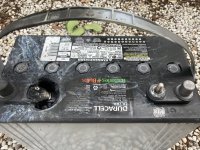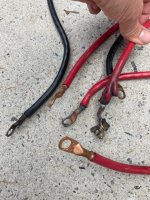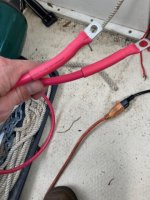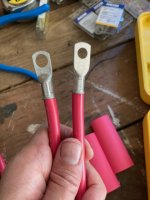I was in the boat on the trailer in the yard updating my chart plotter software, and as I was buttoning everything up I glanced at the Pro sport 20 onboard charger. It was showing a fault in battery 1, I went to the battery selector switch and really without thinking decided to switch it to battery 2, when I did this I heard buzzing from the battery compartment and was unable to pass the switch through the "all" selector to 2, it was stuck on ALL. I backed up and proceeded to watch battery 1 spark, smoke and almost catch fire, quickly I went back to the switch and turned it off, then unplugged the power cord to the boat and grabbed the fire extinguisher, watching this happen next to 10gal of gasoline wasn't very fun.
I unhooked and removed the batteries, battery 1 now has a large golfball sized hole in the top at the positive terminal and battery 2 has a little melting also at the positive post. I used the boat last week no problems. My initial thought was that battery one for some reason was discharged and when I went to "all" battery 2 violently discharged into battery 1 causing the fire. However when I measured the voltage after I removed the batteries, battery 1 was at 12.7v and battery 2 was at 12.6v. Both are about 2 years old, duracell 92ah AGM's. I leave them on the pro charger when not in use, the boat sits in the yard in the trailer when not in use.
I'm not really sure what happened, any ideas? Obviously I want to prevent that from happening again. I ordered a BlueSea battery selector that only has position 1, position 2 and off, no need for "all" as far as I can tell. Should I have had fuses at each batteries positive post? The boat didn't have them and I've been debating on adding them.
I'm planning on going back with similar batteries and the new switch. I really just want to understand what caused this so I can mitigate it in the future.
I unhooked and removed the batteries, battery 1 now has a large golfball sized hole in the top at the positive terminal and battery 2 has a little melting also at the positive post. I used the boat last week no problems. My initial thought was that battery one for some reason was discharged and when I went to "all" battery 2 violently discharged into battery 1 causing the fire. However when I measured the voltage after I removed the batteries, battery 1 was at 12.7v and battery 2 was at 12.6v. Both are about 2 years old, duracell 92ah AGM's. I leave them on the pro charger when not in use, the boat sits in the yard in the trailer when not in use.
I'm not really sure what happened, any ideas? Obviously I want to prevent that from happening again. I ordered a BlueSea battery selector that only has position 1, position 2 and off, no need for "all" as far as I can tell. Should I have had fuses at each batteries positive post? The boat didn't have them and I've been debating on adding them.
I'm planning on going back with similar batteries and the new switch. I really just want to understand what caused this so I can mitigate it in the future.





